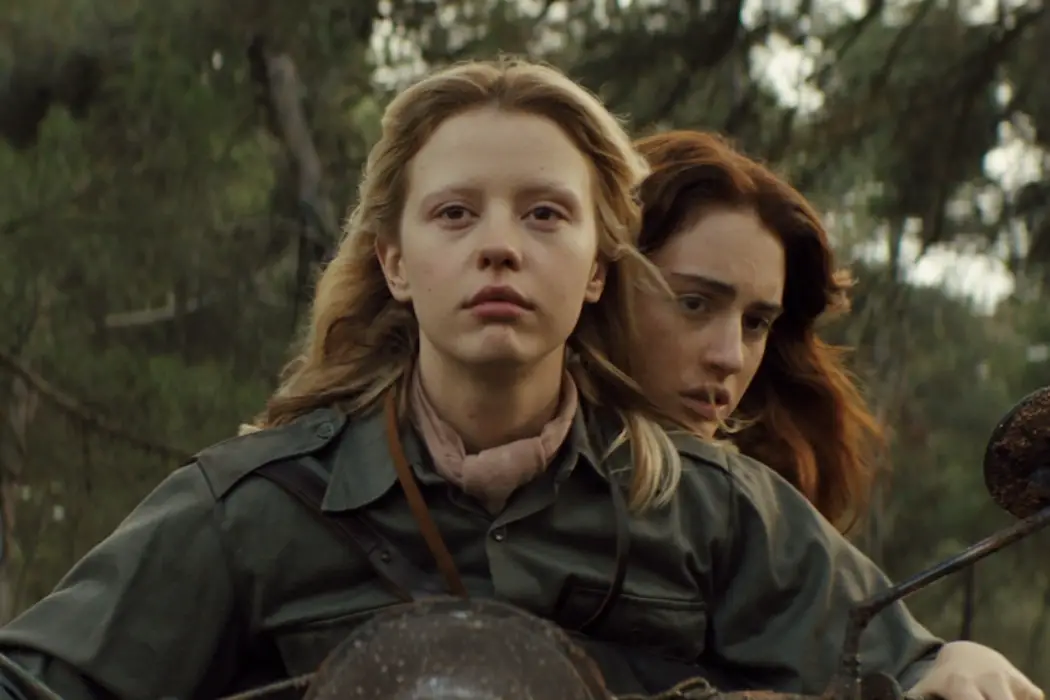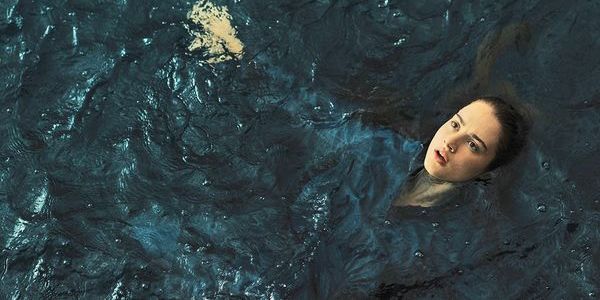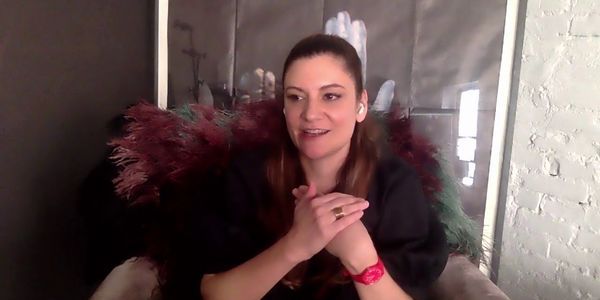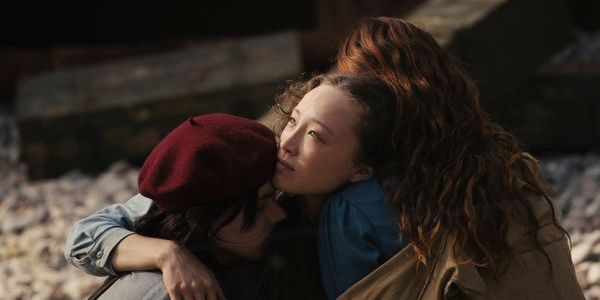International Film Festival Rotterdam 2021: Interview With Director/Writer Karen Cinorre Of MAYDAY

Wilson is a cinema enthusiast based out of Toronto, Canada.…
Female-oriented narratives set in World War II are still a rarity in cinema, and Karen Cinorre was certainly conscious of this fact when creating her feature directorial film, Mayday. Using the myth of the sirens as inspiration, Cinorre has crafted an ominous cinematic experience that delves into the social and emotional intricacies of being a woman, in a predominantly male-centric world. Although the story takes place in a bygone era, its messaging is just as relevant and poignant in present times. Cinorre spoke to Film Inquiry about Mayday during its premiere at the 2021 edition of the International Film Festival Rotterdam.
Wilson Kwong for Film Inquiry: How was the experience of premiering Mayday at Sundance, and then pretty much going to Rotterdam right after?
Karen Cinorre: It was interesting because they’re almost overlapping. When the real world was happening, it would have been very hard to do. So in that way, as a silver lining, I could do both! We’re all disappointed we couldn’t see our films on big screens, but the plus side was that it was great that these festivals just made it work and made it feel like we’re sharing our work.
We’re meeting other filmmakers, and the festivals really did everything they could to help us connect, which I think we all needed to do. And it was nice to share the film with so many people, and it wasn’t just an enclave in either place. Tickets went out to thousands of people all over the country for Sundance and all over the Netherlands for Rotterdam. So that’s something that I’m hoping maybe will become a part of this new hybrid version of a festival.

And because both festivals were virtual, have you been able to gauge the audience response at all? I just wonder if the virtual setting makes it harder or easier.
Karen Cinorre: Well, I’d say social media fills the void. At Sundance or Rotterdam, you come out of the theatre and everyone’s talking. You go to the bar and everyone’s talking, and you get a sense or vibe. This is just different. I got a lot of people Instagramming me, sending me emails, sending things to my website, and just reaching out in a different way. And since we’re so addicted to social media right now, it felt like I could hear a lot of voices from a lot of different places giving me feedback.
It didn’t feel like it was absent, just different. And we’ve gotten a good response. The people who love the film are obsessed with it! It’s always interesting to see what people are going to think, but people are making fan art of the radios and drawing things for us; it’s very sweet. It seems to have some obsessional element to it. I don’t know why, but it’s very lovely to have people sending these incredible versions of their own Mayday land.
Since Mayday is abstract in so many ways, I’m just curious, what was the initial kernel of an idea for the film?
Karen Cinorre: It was really simply a coming of age story for a young woman. And then one of my big inspirations is Greek mythology, so the myth of the sirens has always intrigued and haunted me. These mythological women characters are so powerful and different from any clichéd narrative women that I’ve ever seen. I guess I wanted to do a transformative story for a coming of age, young woman, using the influences that I felt so strongly tied to in my own coming of age; which were really mythological versions of women. And the sirens were the perfect image for me to imagine her being lured into another world.
What about the time period of the film? Was the idea always to set it during that time period? Or was there thought to setting it in the present time?
Karen Cinorre: The time period was up for grabs when I was writing it, but it always just logically came back to a World War II look. I think in cinema, there is no end to World War II movies and they are omnipresent at all times. I just grew up watching so many World War II movies, and to me, the typical male hero has always been the World War II hero. So it made sense to make a film like this [with female characters] in that time period.

But despite taking place during World War II, many of the film’s themes seem pretty relevant to present-day times too. In your mind, is that also the case, or do you consider Mayday more of a period piece?
Karen Cinorre: To me, it’s very relevant to now. But at the same time, it comes from a place of thought of thousands of years old. The Methodist sirens are thousands of years old, but I think it’s still relevant in terms of the way that women are portrayed as a bit devious, a bit evil, and a bit powerful.
In World War II, there were actually women who became radio broadcasters, who were like modern-day sirens who would lure sailors to their death and demoralize them with these radio shows (like Tokyo Rose and Axis Sally in particular). I just think that the whole idea of turning a woman’s voice against her, it was something that happened in my upbringing. It’s something that happens in a lot of women’s upbringing, and it’s something that’s transported all through the ages. So I see it as very contemporary and ancient in a way, doing something that’s a part of our culture and always has been.
In terms of preparing the actresses, did you have a lot of conversations with them about how they interpreted the script? Or did you guide them with your intended interpretation?
Karen Cinorre: All five actors came to me with a very strong connection to the script. So it was like they read it, they got it, and they came to me and said, “I get it, and I want to do it.” I didn’t have to explain a lot. They might have certain questions about how to approach something, but they felt a really heartfelt connection to it for some reason in their own lives. And that was the starting point, which seemed like the logical starting point.
All the performances are so strong. Did they have their own opinions about the characters that ended up changing the script’s version of the characters? Or were the characters we saw on screen pretty much what you had on the page?
Karen Cinorre: They were all what I imagined, but 10% more. To have the thing embodied is a remarkable thing in any case, but they all worked so hard to really fulfill the dream of this being a transportive film. And so they brought this extra energy and magic to the roles.
And for instance, Mia Goth, I love her work and knew that she was just going to be such a great Marcia. But the intensity that she brought to it, the extra thinking about the character, and how her relationship to the cosmos was a whole extra layer to the characters that they brought to me. I learned more about the characters and what I loved about these actors is that it never felt extraneous. It always felt like the character that I had imagined. So it was collaborative in a very nice way.
As far as the actual locations of where you shot the film, correct me if I’m wrong, but it seems like the film was mostly shot on location?
Karen Cinorre: We built everything, everything’s real. I like to work in camera and I’m not a big fan of CGI. We went to Northern Croatia, Istria, and our production designer is from Zagreb, who’s done a lot of work up there. He was very pleased to build a submarine, a submarine exterior, two submarine interiors, two airplanes, find a c*ckpit, and find an American car. He was just fearless, threw himself into the project, and just had a blast making a world. The creations are so warm and they have this incredible landscape of course. We didn’t have a big budget, we just had big ideas and they loved that. They were so happy to have someone come from America and do this crazy movie with them.

And on the same line, in terms of the cinematography for the film, can you talk about what kind of direction you gave your cinematographer to create the look and feel of the film?
Karen Cinorre: We thought a lot about how the actresses’ bodies would move through space. I have a strong dance background and we actually looked at some dances for reference. There’s a dance theatre company called Rosas in Belgium and I love their work. Some of her work has even a touch of a militaristic feel, but it’s also playful, and that kind of movement and energy was extremely important to us when we were thinking about how everything would move around. And then we thought a lot about colour, and we had a lot of Japanese references for that. I was very attracted to a couple of photographers who manage to create night exteriors that looked quite luminous, but not overly artificial. It’s just very special.
It’s funny, there have been three or four people I’ve interviewed this past week who’ve used photography as a reference. I’m always more used to filmmakers talking about other films as their sources of inspiration.
Karen Cinorre: Oh, that’s interesting. We always go right to our favourite bookstore. We look at photographs, we definitely watch tons of films, but we really wanted to create something that felt different. So you didn’t really want to reference another film – of course, your brain will – but we wanted to see what we could find that felt right for the story and not be overly influenced by something that was a film. We wanted to go at it a little bit from a diagonal.
And what was the most challenging thing about making Mayday?
Karen Cinorre: Croatian winds. They have names for all the various howling winds in Croatia that come from the Adriatic Sea. One named Jura blew in one night and within minutes destroyed our main set. Luckily we had just finished our scenes there the day before, so at least Jura was polite.
I know we’re still in the midst of the pandemic right now, but where do you see a film like being released? Or what’s your ideal version of that release plan?
Karen Cinorre: None of us know. Day by day, everything changes. The whole team would like to see some theatrical release, and I’m surprised how many people are optimistic about it. People are getting vaccinated, things are happening, so I think it’s possible. And I love a big canvas. I love that the movie is spectacular and big. I haven’t even seen it that much because I had to make it remotely, and we didn’t have as much access to a screen as I normally would. When I finally saw it, masks on, tiny theatre, I was just blown away because the scale is so different. And the ocean covering the entire screen, I would love to share it that way. Our sales reps and distributors are quite in love with theatrical experiences, so we’re doing our best and who knows how big that will be.
Film Inquiry would like to thank Karen Cinorre for taking the time to speak with us!
Does content like this matter to you?
Become a Member and support film journalism. Unlock access to all of Film Inquiry`s great articles. Join a community of like-minded readers who are passionate about cinema - get access to our private members Network, give back to independent filmmakers, and more.
Wilson is a cinema enthusiast based out of Toronto, Canada. He escapes from his day job by writing random thoughts about cinema on the internet. Although he has a longstanding penchant for Hong Kong cinema, he considers himself to be an advocate for Asian cinema in general. He has been attending the Toronto International Film Festival every year since 2005, and more of his work can be found on his website: www.wilson-kwong.com.













